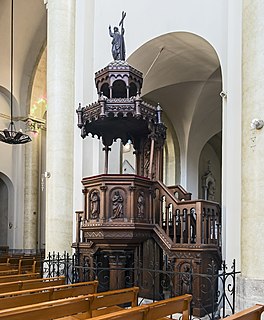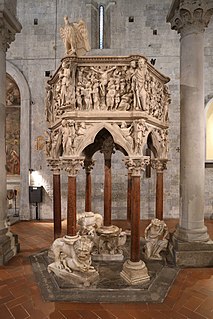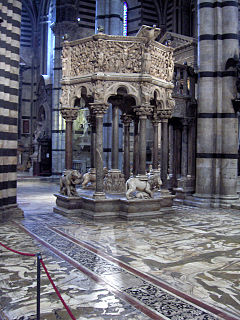 W
WA pulpit is a raised stand for preachers in a Christian church. The origin of the word is the Latin pulpitum. The traditional pulpit is raised well above the surrounding floor for audibility and visibility, accessed by steps, with sides coming to about waist height. From the late medieval period onwards, pulpits have often had a canopy known as the sounding board, tester or abat-voix above and sometimes also behind the speaker, normally in wood. Though sometimes highly decorated, this is not purely decorative, but can have a useful acoustic effect in projecting the preacher's voice to the congregation below. Most pulpits have one or more book-stands for the preacher to rest his or her bible, notes or texts upon.
 W
WThe ambon or ambo is a projection coming out from the soleas in an Eastern Orthodox, Oriental Orthodox and Eastern Catholic church. The ambon stands directly in front of the Holy Doors. It may be either rounded or square and has one, two, or three steps leading up to it.
 W
WThe Ambon of Henry II, commonly known as Henry's Ambon (Heinrichsambo) or Henry's Pulpit (Heinrichskanzel) is an ambon in the shape of a pulpit built by Henry II, Holy Roman Emperor in the Palatine chapel in Aachen between 1002 and 1014. It is among the most significant artworks of the Ottonian period.
 W
WA lectern is a reading desk with a slanted top, on which documents or books are placed as support for reading aloud, as in a scripture reading, lecture, or sermon. A lectern is usually attached to a stand or affixed to some other form of support. To facilitate eye contact and improve posture when facing an audience, lecterns may have adjustable height and slant. People generally use lecterns while standing.
 W
WA minbar is a pulpit in a mosque where the imam stands to deliver sermons. It is also used in other similar contexts, such as in a Hussainiya where the speaker sits and lectures the congregation.
 W
WPisa Cathedral is a medieval Roman Catholic cathedral dedicated to the Assumption of the Virgin Mary, in the Piazza dei Miracoli in Pisa, Italy. It is a notable example of Romanesque architecture, in particular the style known as Pisan Romanesque. It is the seat of the Archbishop of Pisa.
 W
WA preaching cross is a Christian cross sometimes surmounting a pulpit, which is erected outdoors to designate a preaching place.
 W
WThe pulpit in the pieve of Sant'Andrea, Pistoia, Italy is a masterpiece by the Italian sculptor Giovanni Pisano. The work is often compared to the pulpits sculpted by Giovanni's father Nicola Pisano in the Baptistery of Pisa and the Duomo of Siena, which Giovanni had assisted with. These very advanced works are often described in terms such as "proto-Renaissance", and draw on Ancient Roman sarcophagi and other influences to form a style that represents an early revival of classical sculpture, while also remaining Gothic, and drawing on sources such as French ivory carvings.
 W
WThe Siena Cathedral Pulpit is an octagonal structure in Siena Cathedral sculpted by Nicola Pisano and his assistants Arnolfo di Cambio, Lapo di Ricevuto, and Nicolas' son Giovanni Pisano between the fall of 1265 and the fall of 1268. The pulpit, with its seven narrative panels and nine decorative columns carved out of Carrara marble, showcases Nicola Pisano's talent for integrating classical themes into Christian traditions, making both Nicola Pisano and the Siena pulpit forerunners of the classical revival of the Italian Renaissance.
 W
WA sounding board, also known as a tester and abat-voix is a structure placed above and sometimes also behind a pulpit or other speaking platforms that helps to project the sound of the speaker. It is usually made of wood. The structure may be specially shaped to assist the projection, for example, being formed as a parabolic reflector. In the typical setting of a church building, the sounding board may be ornately carved or constructed. The term "abat-voix," from the French word for the same thing, is also used in English.